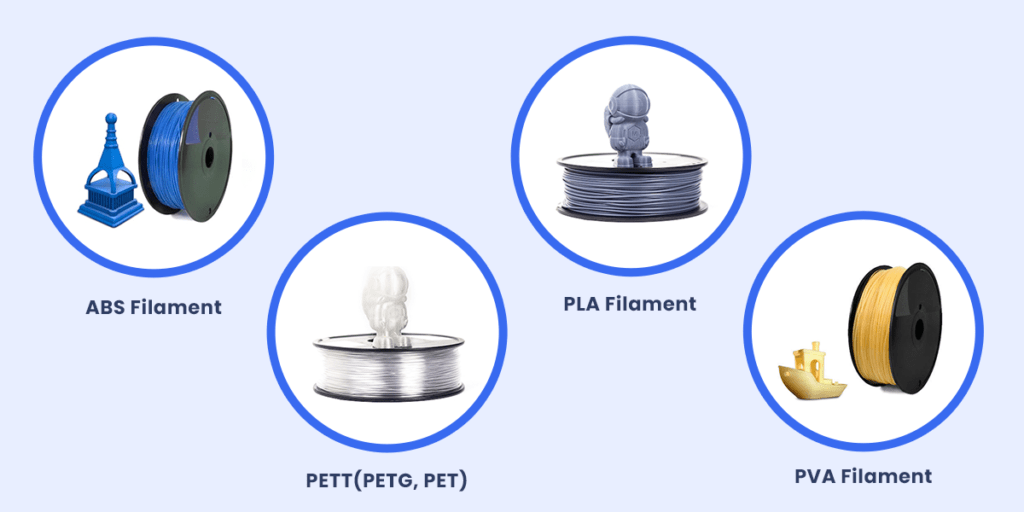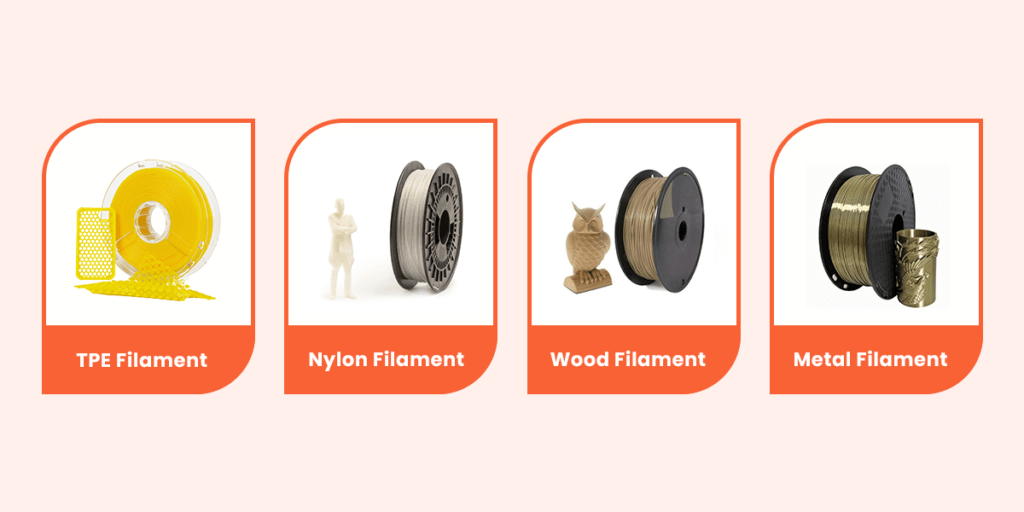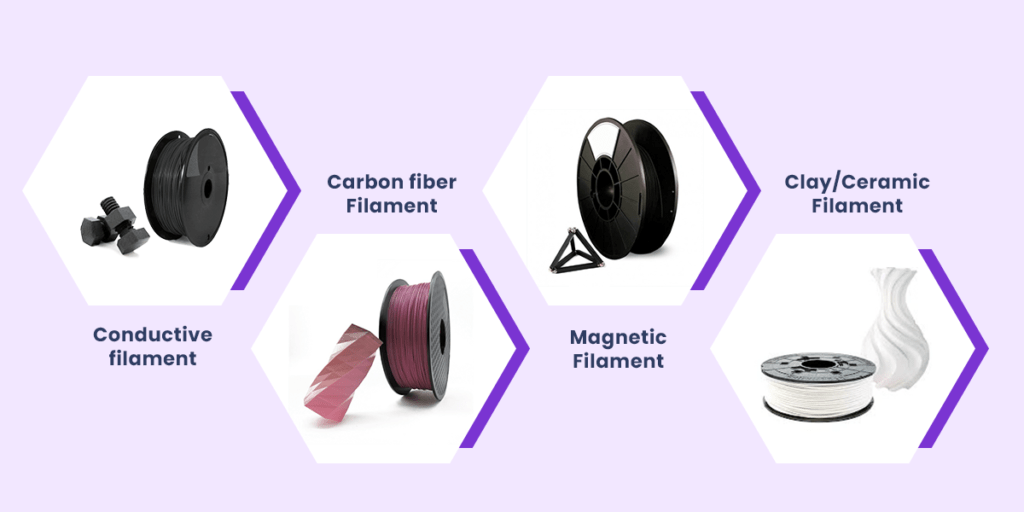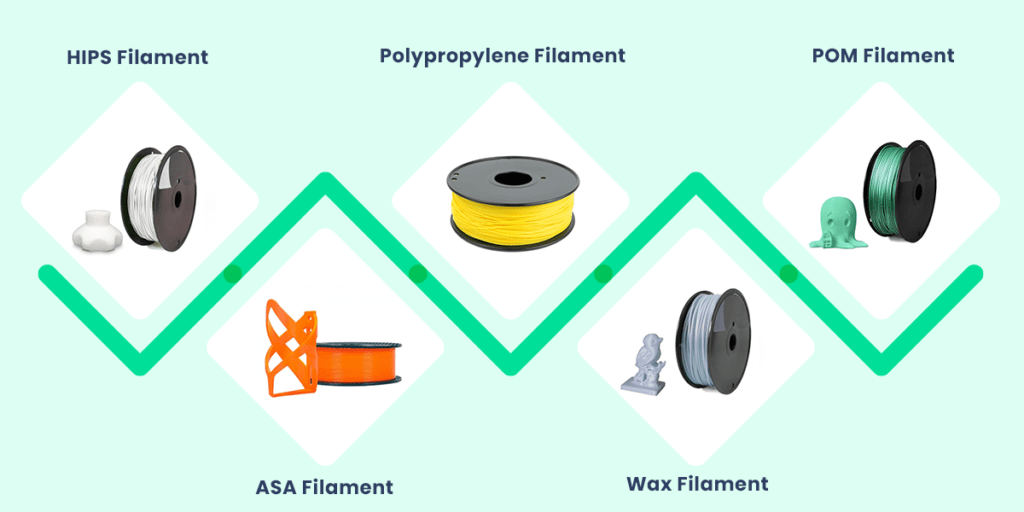Once you start 3D printing, you have to choose an ideal 3D printing filament that suits your requirements. There are many filaments available, and choosing the right one has to be an informed choice.
You might have to consider a few factors before choosing a filament, such as, what should be the strength of your printed part? What kind of precision and accuracy are you looking for? How flexible your part needs to be? Etc. So following is a list of some popular 3D printing filaments that will help you determine the right choice for your 3d printing project.

ABS
With its high impact resistance and toughness, ABS is one of the most popular 3D printing filaments. It’s strong, and a bit flexible and can be easily extruded.
The Pros
- Lightweight and durable
- Cheap cost
- Flexible
- Preferred among professionals and newbies alike
The Cons
- Unpleasant fumes
- Non-biodegradable because of being petroleum-based
- Warps easily
- Requires high temperature to melt
Applications
ABS is most used in making toys, moving parts, and electronic parts. It is also used in bicycle helmets, automotive components, wedding rings, phone cases, car phone mounts, etc.
PLA
PLA is highly used in consumer-grade 3d printing products. It is also one of the most popular 3d printing filaments in general. It is available in different colours. It is also biodegradable and doesn’t warp easily.
The Pros
- Biodegradable
- Easily printable
- Comes in translucent and glow in the dark colours
- Produces a good, candy-like smell
The Cons
- Brittle
- Can jam or clog the printer nozzle at times
Applications
PLA is often used in prototype parts, medical implants, food containers, low-wear toys, etc.
PETT (PETG, PET)
PET (polyethylene terephthalate) is a very common plastic type. It is often used in food containers and plastic bottles. For 3d printing, PETG is used, which is a variant of PET. The ‘G’ here stands for ‘glycol-modified.’ This modification makes the filament easier to print and less brittle.
The Pros
- High flexibility and strength
- High resistance to impact and temperature
- Easy to print
The Cons
- Hygroscopic (absorbs moisture from the air, so proper storage is required)
- The surface can be easily scratched.
Applications
PET is often used in phone cases, electronics, mechanical components, jewelry, protective components, etc.

PVA
Polyvinyl alcohol is biodegradable and non-toxic. Not only is PVA easy to print, but also it acts as a good support material for different overhangs while 3d printing.
The Pros
- Durable
- Water-soluble
- Non-toxic and biodegradable
- Easy to print
The Cons
- High cost compared to other materials
- Not easily available
- Hygroscopic (absorbs moisture from the air)
Applications
PVA is often used in packaging films, paper adhesive thickeners, and children’s toys.
TPE
Thermoplastic elastomers (TPE) are plastics but have rubber-like qualities. This renders them durable and flexible. TPE can withstand physical stress to a high degree as it is stretchable and soft. TPE objects can withstand a considerable amount of wear and can be used in environments where a high degree of bending, compression, and stretching is required.
The Pros
- High flexibility
- Can sustain bending and compression
- Robust
The Cons
- Slow print speed
- Not easy to print
Nylon
Nylon is already used in many industrial components and is one of the most used filaments for 3d printing. When considering strength, durability, and flexibility, Nylon comes forth as the most logical choice for 3d printing.
Nylon is also unique because you can dye it before or after printing. If you want to create functional prototypes, tools, gears, buckles, hinges, etc., then Nylon is a good option owing to its strength and durability.
Pros
- Flexibility, durability, and strength
- Can be used after remelting
- Thermoplastic
- Less brittle than ABS and PLA
Cons
- Hygroscopic
- Expensive
- Can emit toxic fumes when heated
- Requires high print bed temperature
Wood
Wood filaments are, in reality, PLA infused with wood fibre. This combination allows you to print objects that look and feel like wood. The wood that is used with PLA can be willow, ebony, pine, birch, etc. Although you can make aesthetically superior parts with wood filaments, strength and flexibility will be lower than in other materials. While using wood, you’ll have to be cautious with the temperature because too much can damage or burn the material. Also, there’s a chance that wood filament can cause wear to your printer’s nozzle.
You can use wood with objects that are meant for good appearance as opposed to performing complex functions. Decoration items that are to be displayed on tables, shelves, or desks can be printed using wood filament. You can also create scale models using this filament.
Pros
- Aesthetically superior. Best suited for models.
- You can cut and paint models.
Cons
- Weaker in strength
- Less flexibility
- Can cause wear and tear to the nozzle
Metal
Metal filaments can offer a great way to create models that have a lustre and are bulky. Metals filaments are made from a combination of ABS/PLA and metal powder. The weight and look of the final model are just like pure metal because metal blends are denser than PLA and ABS.
In terms of commercial availability, you can use filaments that are made using brass, aluminum, copper, bronze, and stainless steel. Like wood filament, metal powder grains are abrasive and can affect the life of your nozzle. You can use metal filaments if you are looking for a mix of visual appeal and functionality. Tools, toys, models, and finishing components can be manufactured using metal filament.
Pros
- Visual appeal, metallic look, and finish
- Little shrinkage and warping during cooling
- Durability
Cons
- Abrasive to nozzle
- Not easy to print

Conductive filament
Conductive filaments are unique in the sense that they can conduct electricity. Conductive filaments are PLA and ABS materials with added conductive carbon particulates. These filaments are great for small-scale electronic projects. The filament can be used in digital keyboards, circuit boards, gaming controllers, etc.
Pros
- Doesn’t require a heated bed
- Suitable for electronics projects
Cons
- Warps/shrinks during cooling
- Not flexible
- Not durable
Carbon Fiber
Carbon fibres filaments are formed by reinforcing ABS, PLA, etc. with carbon fibre. The final product is rigid, stiff, and is relatively lightweight. Carbon fibre materials are widely used in structural applications, but printing such materials frequently can cause the wearing of your printer’s nozzle.
Because of less density and better structural strength, many mechanical components can be printed using carbon fibre filaments.
Pros
- Improved structural properties
- Lightweight
- Minimal shrinkage during cooling
Cons
- It causes wear and tears on the printer’s nozzle.
Magnetic
When powdered iron is mixed with PLA or ABS, the resulting product is a magnetic filament. The material is ferromagnetic and is attracted to objects with a magnetic field. The material also has a gunmetal finish. You can print tools and toys with this material.
Pros
- Aesthetically appealing
- Strong and durable
- Can stick to magnets
Cons
- Requires very specific post-processing
- Expensive
- Needs a heated bed

Clay/Ceramic
The vast majority of materials being used in the industry consist of plastic. Among the few non-plastic options that are available, clay is very popular. The clay filaments are typically made of clay and copper. The filament is very brittle and is often used for faux-pottery. Products that are required to have a handmade earthenware look can be printed using this material.
Pros
- Properties similar to clay
- Can be fired in a kiln
Cons
- Expensive
- Parts can shrink/warp during cooling
HIPS
HIPS (high impact polystyrene), combines the elasticity of rubber with the hardness of polystyrene. It is a copolymer and is often used to manufacture protective packaging. HIPS materials are commonly used to print ‘supports’ during printing 3d models. Supports are used to hold overhang materials.
Pros
- Stronger than PLA/ABS
- Less shrinkage/warping than ABS
- Can be painted easily
Cons
- Can be only used with ABS
- Has adhesion and curling issues
ASA
ASA or acrylonitrile styrene acrylate is considered as a weather-resistant material. The ASA filaments are easy to print and are relatively rigid and strong. A significant benefit is that ASA can resist exposure to chemicals and heat. Unlike ABS, models printed from ASA don’t denature and turn yellow upon exposure to heat and sunlight.
Pros
- Warps less as compared to ABS
- Suitable for making automotive parts
Cons
- Can crack during printing
Polypropylene
Polypropylene (PP) has a broad range of applications because of its many favourable properties. The material is resistant to chemicals and is also lightweight, flexible, and tough. Textiles, engineering plastics, and food packaging industries often use this material.
When it comes to 3d printing, PP is not a very user-friendly material. It can warp a bit too much and lacklustre layer adhesion. These are the reasons that PP is not in the league of ABS and PLA despite having one of the best chemical and structural properties. Generally, PP is suitable for materials that need to be printed with a lightweight but need to have considerable strength as well.
Pros
- High strength and durability
- Resistant to chemicals
Cons
- Poor layer adhesion
- Not easy to print
- Can warp considerably
Wax
Wax material is used in investment casting. Wax filaments allow you to create parts that resemble metals like tin, brass, etc. Wax materials are softer than the majority of other filaments. However, you need to modify your extruder a bit. The print bed might need to be layered with an adhesive as well.
Pros
- Allows you to make moulds from your printer
Cons
- Limited applications
- Modification required to your printer for using it
Acetal (POM)
Acetal is also known as POM (polyoxymethylene) and is often used in plastic parts that require high precision. Acetal is also used in zippers, bearings, gears, and camera focusing mechanisms. Because of its strength and rigidity, Acetal is highly preferred for these applications. It also makes for a good 3d printing material owing to its low coefficient of friction. Acetal can be used in moving parts where toughness and low friction are a requirement.
Pros
- High strength and rigidity
- Resistant to chemicals and heat
- Best suited for functional applications
Cons
- High print bed temperature required
- First layer adhesion is not easy.



